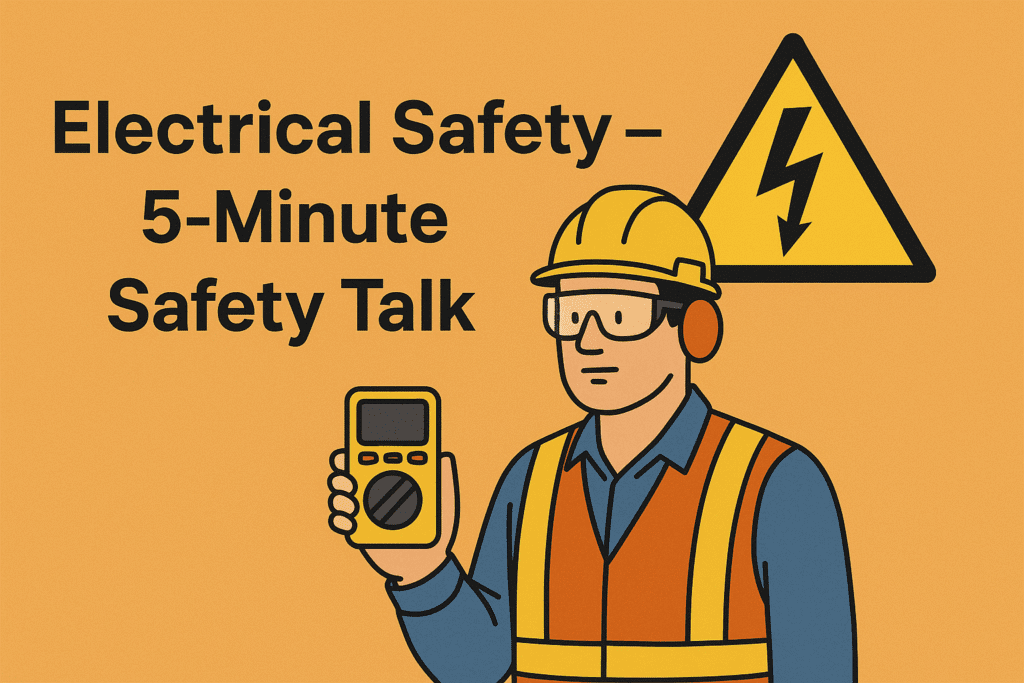
Electrical Safety 5 Minute Safety Talk
Good morning team,
Today’s toolbox talk is about something we often take for granted—electricity. We use it every day to power our tools, lights, and equipment, but it’s also one of the most dangerous hazards on any worksite if not handled correctly.
Electrical incidents happen in an instant—and they can be deadly. Electrocution, burns, and even explosions can result from just one careless mistake. So for the next five minutes, let’s talk about how we can stay safe when working around electricity.
Why Electrical Safety Matters
Electricity is silent and invisible—you won’t always see the danger coming. That’s why it’s crucial to follow strict safety protocols every time you’re near or working with electrical systems.
Injuries from electrical accidents include:
- Electrical shocks and electrocution
- Burns from arc flash or faulty wiring
- Fires caused by overheating circuits
- Falls from ladders due to electric shock
Even low-voltage systems can be deadly in the wrong situation.
Common Electrical Hazards on Site
Keep your eyes open for these high-risk situations:
- Damaged extension cords or plugs
- Exposed wiring or open junction boxes
- Overloaded circuits or panels
- Wet conditions near electrical equipment
- Tools used near overhead power lines
- Equipment not properly grounded
If it looks unsafe—it probably is. Report it immediately.
PPE for Electrical Safety
The right Personal Protective Equipment (PPE) can be a lifesaver around electricity.
Depending on the task, this may include:
- Insulated gloves
- Dielectric safety boots
- Flame-resistant clothing
- Face shields or arc-rated helmets
- Safety glasses with side protection
Always check your PPE before use, and never skip it—even for “quick jobs.”
Lockout/Tagout (LOTO) Saves Lives
Lockout/Tagout is a procedure to ensure that equipment is completely de-energized before anyone performs maintenance or repairs.
Steps include:
- Turn off and isolate the energy source
- Lock it out using appropriate devices
- Tag it with a warning sign
- Test to confirm zero energy
Never assume equipment is safe—test and verify.
Water and Electricity Don’t Mix
Water increases conductivity, which means even a small voltage can become deadly when your hands or the surface are wet.
Key rules:
- Never handle electrical tools or cords with wet hands
- Keep cords and equipment away from puddles
- Use ground fault circuit interrupters (GFCIs) in damp areas
If it’s wet—wait or relocate.
Inspect Before You Use
Before using any electrical tool or extension cord:
- Check for frayed wires
- Ensure plugs are intact and not damaged
- Confirm tools are properly grounded or double-insulated
- Don’t “tape up” damaged cords—replace them
A five-second check can prevent a life-altering injury.
Don’t Take Shortcuts with Power
We’ve all heard it: “Just plug it in quickly,” or “Use that damaged cord, it still works.”
But shortcuts and improvisation are what lead to injuries and even fatalities.
- Never bypass breakers
- Don’t “hot wire” equipment
- Don’t overload outlets
- Always use the correct rating for fuses and cables
When it comes to electricity, there’s no room for shortcuts.
Quick Electrical Safety Checklist
- Have I inspected all cords and plugs before use?
- Is my equipment grounded or double insulated?
- Am I using a GFCI in wet or outdoor areas?
- Is the work area dry and clean?
- Am I wearing the correct PPE?
If any of these boxes aren’t checked—stop and fix it first.
Real-Life Example
A worker using a power drill in a damp area received a severe electric shock when the insulation failed. There was no GFCI in place, and the drill had not been inspected. The worker lost consciousness and suffered burns.
This was entirely preventable—with one safety check.
Speak Up for Safety
If you ever see a dangerous electrical situation—don’t ignore it. Report it, fix it if safe to do so, and never let unsafe work continue just to save time.
Your life is worth more than a shortcut.
Conclusion
Electricity is essential, but it doesn’t take much to turn it from helpful to harmful. Every time you plug something in, work near a panel, or pick up a tool, remember: respect electricity.
Use the right PPE. Inspect your equipment. Never work wet. And always follow lockout/tagout procedures when required.
Because when it comes to electrical safety, there’s no such thing as “just this once.”
Housekeeping 5 Minute Safety Talk
Create Your Own Toolbox Talk Presentation – Step-by-Step
Slips, Trips, and Falls Safety Talk
Fall Protection Systems Safety Talk
Compressed Gas Cylinder Safety Talk
5 Unique FAQs
Q1: Can low voltage still be dangerous?
Yes. Even 50 volts can be enough to cause harm under the right conditions, especially in wet environments.
Q2: What should I do if I see exposed wires?
Stay away, warn others, and report it immediately to your supervisor or safety team.
Q3: Why is GFCI important?
GFCI (Ground Fault Circuit Interrupter) devices detect leakage and trip the circuit before a shock becomes deadly—especially important in wet or outdoor areas.
Q4: Can I wrap a damaged cord with electrical tape?
No. That’s a temporary fix at best and does not restore the cord’s insulation or safety. Replace the cord entirely.
Q5: How often should I inspect my power tools?
Before every use. A quick visual inspection can save you from serious harm.